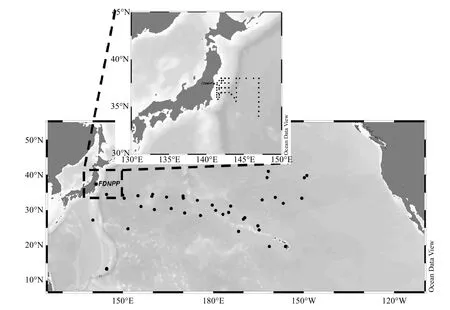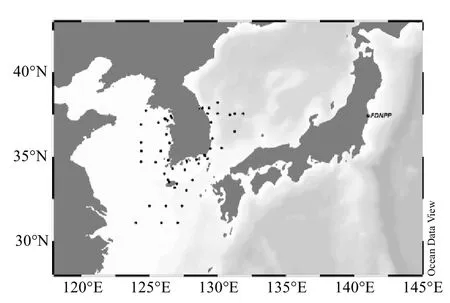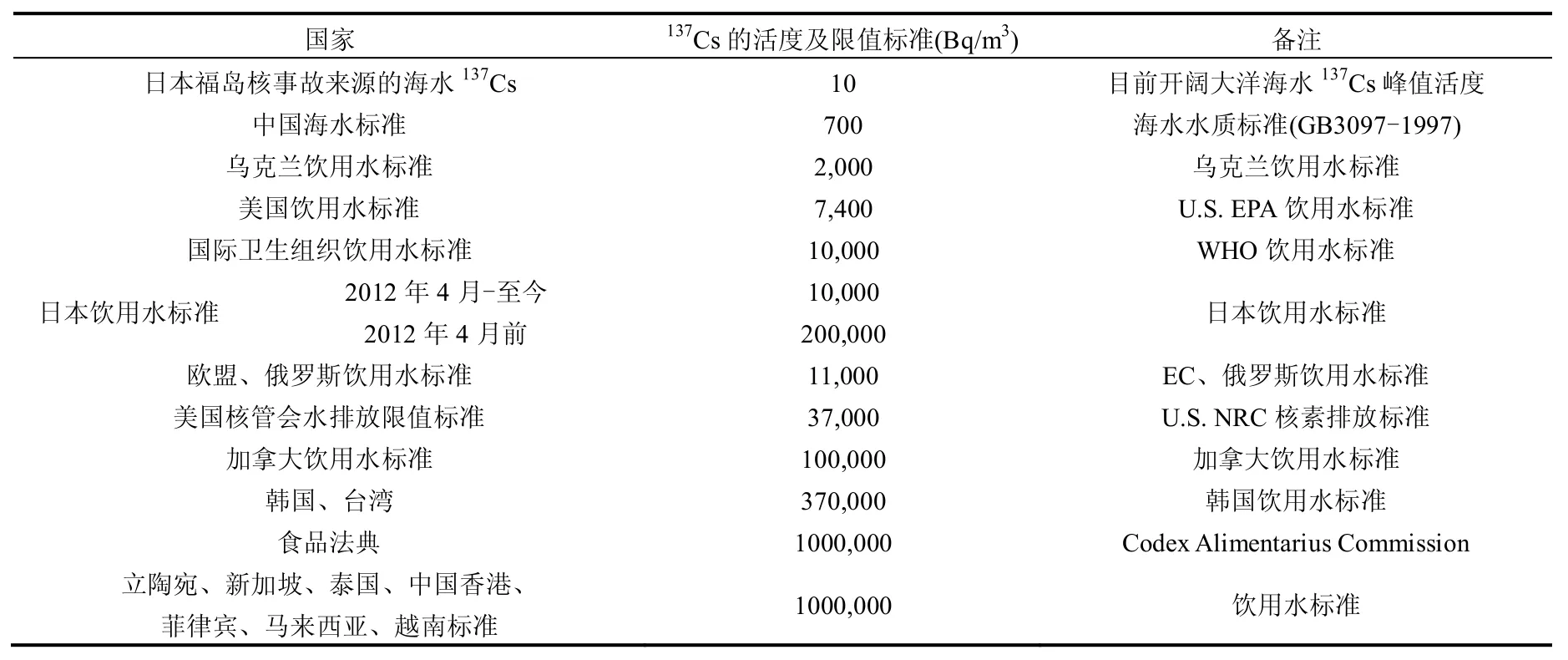日本福岛核事故后的海洋放射性监测进展
林武辉,陈立奇,何建华,马 豪,曾 志,曾 实(.清华大学工程物理系,北京 00084;2.清华大学粒子技术与辐射成像教育部重点实验室,北京 00084;3.国家海洋局海洋放射性技术与环境安全评估实验室,福建 厦门 36005;4.国家海洋局海洋大气化学与全球变化重点实验室,福建 厦门 36005;5.国家海洋局第三海洋研究所,福建 厦门 36005)
日本福岛核事故后的海洋放射性监测进展
林武辉1,2,3,4,5,陈立奇4,5*,何建华3,5,马 豪1,2,曾 志1,2,曾 实1(1.清华大学工程物理系,北京 100084;2.清华大学粒子技术与辐射成像教育部重点实验室,北京 100084;3.国家海洋局海洋放射性技术与环境安全评估实验室,福建 厦门 361005;4.国家海洋局海洋大气化学与全球变化重点实验室,福建 厦门 361005;5.国家海洋局第三海洋研究所,福建 厦门 361005)
全面总结日本福岛核事故后不同核素通过海洋途径排放的放射性总量;介绍多个国家开展的海洋放射性监测工作;基于海洋放射性本底与各国制定的限值标准,对福岛核事故后海洋放射性监测结果进行评价;最后对国内外的海洋放射性监测工作进行展望,从海洋环境安全角度出发,提出建立我国海洋放射性数据库的必要性.
福岛核事故;海洋放射性监测;核电站;标准;数据库
2011年3月日本福岛核事故泄漏的放射性物质80%进入太平洋,19%沉降于日本,不到1%沉降于北美、欧亚大陆等地区[1-5],该事故是至今为止最为严重的海洋放射性污染事故.事故之后,许多国家相继开展海洋放射性监测工作,并积累大量海洋放射性监测数据.本工作总结了2011年发生的福岛核事故后的3年来,多个国家开展的海洋放射性监测工作和进展,基于海洋放射性本底与各国制定的限值标准,对福岛核事故后海洋放射性监测结果进行评价,并对国内外的海洋放射性监测工作进行展望,提出建立我国海洋放射性数据库的必要性.
1 福岛核事故后放射性物质的海洋排放总量
核事故泄漏的放射性物质总量是事故分级的依据,是后果评价的基础.许多国家、机构、学者根据环境放射性监测结果并结合模型对事故后的放射性物质排放总量进行估计,本文全面汇总不同核素通过海洋途径排放的放射性物质总量,并对福岛核事故泄漏的放射性总量进行简单估计.
1.1 海洋排放
福岛核事故是至今为止最严重的海洋放射性污染事故,大量放射性物质通过液态排放直接进入海洋环境[6].表1总结福岛核事故后不同核素进入海洋环境的放射性排放总量,部分核素有多个估算值,数据主要来源于已经过同行评审的公开发表学术文献和政府及国际组织的工作报告.

表1 海洋途径排放放射性物质总量估计(1015Bq)Table 1 Source term estimation of radionuclides by oceanic pathway (1015Bq)
131I、134Cs和137Cs发射γ射线,其测量方法相对容易,所以在事故后有大量的海水监测数据,而且三者是事故排放的主要核素,是对人类、生物产生电离辐射危害的主要贡献核素,因此其排放量的估算研究较为丰富,131I、134Cs、137Cs海洋排放的源项分别为10~61PBq、2~20PBq、1~30PBq.不同排放时间及海域的界定、不同来源的气象与水文数据的选取、不同模型的应用、不同来源的监测数据的校准等因素,都导致福岛核事故的源项估计存在一定的不确定性.今后仍然需要利用更多手段,从不同角度出发定量源项,减少源项评估过程中的不确定度.
1.2 福岛核事故放射性物质泄漏总量估计
日本福岛核事故虽然被定为7级核事故,但是如果不考虑放射性惰性气体(85Kr、133Xe)的排放,福岛核事故放射性物质泄漏总量为520PBq,大约为前苏联的切尔诺贝利核事故放射性物质泄漏总量的10%~15%[25],但是由于核电站厂区附近的核事故后续地下水等过程的放射性排放量尚未充分考虑,该估算结果仍然存在一定的不确定性;如果考虑惰性气体的排放,福岛核事故放射性物质排放总量大于切尔诺贝利核事故的放射性排放总量,因为福岛核事故有4个反应堆发生不同程度的堆芯熔化,而切尔诺贝利核事故只有一个反应堆发生熔化[1].
2 核事故后的海洋放射性监测工作
日本福岛核事故后,多个国家相继开展大量的海洋放射性监测工作,本文对日本、美国、韩国、俄罗斯、中国在北太平洋开展的放射性监测工作进行总结.
2.1 日本
福岛核事故之后,日本在近岸、北太平洋开展大量的海洋放射性监测工作,监测海域包括日本近岸[26-31]、日本海[32-33]、北太平洋[34-41],测量的主要核素是134Cs、137Cs.3年来的近岸和开阔大洋的连续监测表明,事故初期福岛近岸的海洋环境受到福岛核事故的强烈影响,海水137Cs最高活度达到6.8×106Bq/m3,事故后期由于海水不断稀释及放射性排放量的有效控制,海水中放射性核素的活度不断下降,开阔大洋海水137Cs最高值在10Bq/m3.图1收集了上千个日本开展的放射性监测站位空间分布图,虚线方框区域放大后的图显示的是日本近岸监测站位情况.
开挖前,需保证施工区域土层密实平整,稳定性好,周边施工空间无障碍物,悬吊机具的钢丝索必须在导墙中心线上成垂直状态,不能松弛,才能保证成槽垂直精度,待确保施工区域土层稳定后,以最小角度定位。
2.2 美国
核事故泄漏的大量放射性物质进入海洋,将通过大洋环流影响美国西海岸[42].福岛核事故之后,美国联合日本、英国、西班牙等其它国家于2011年6月4~18日在西太平洋开展放射性监测,监测核素包含3H、110mAg、89Sr、90Sr、129I、134Cs、137Cs、226Ra、228Ra,图2虚线框放大后的图给出该航次的站位空间分布[7,19],美国部分高校也开展北太平洋海水中134Cs、137Cs的测量工作,并画于图2[43].美国监测结果表明,事故后2年,夏威夷附近海域的海水137Cs活度范围是1~4Bq/m3,是事故前的2~3倍.

图1 福岛核事故后日本在近岸及北太平洋监测站位空间分布Fig.1 Radioactive monitor stations near the coast of Japan and Pacific Ocean after the FNA (Data from Japan)

图2 福岛核事故后美国等开展的海洋放射性监测站位空间分布Fig.2 Radioactive monitor stations in the North Pacific Ocean after the FNA (Data from the USA)
2.3 韩国
福岛核事故之后,韩国作为日本临近国家,于2011年3~7月开展大量海洋放射性调查,主要区域为其近岸海域、黄海、东海及日本海[44],监测核素包含90Sr、131I、134Cs、137Cs、239+240Pu,具体空间站位如图3,该研究表明韩国近岸海域并未观测到来自福岛核事故的放射性核素的信号.

图3 福岛核事故后韩国海洋放射性监测站位空间分布Fig.3 Radioactive monitor stations of Korean after the FNA
2.4 俄罗斯
福岛核事故之后,俄罗斯立即开展海洋放射性监测,于2011年4~5月、2012年8~9月在日本海、西太平洋开展海水放射性测量[45],测量核素包含3H、90Sr、134Cs、137Cs、239+240Pu等,总共监测21个站位,研究结果表明日本以东海域海水137Cs储量比事故前高4.6倍,具体空间分布参考图4.

图4 福岛核事故后俄罗斯海洋放射性监测站位空间分布Fig.4 Radioactive monitor stations of Russia after the FNA
2.5 中国

图5 福岛核事故后中国海洋放射性监测区域Fig.5 Radioactive monitor regions of China after the FNA
3 福岛核事故后海洋放射性监测总结及评价

表2 表层海水中的放射性核素活度分布[50]Table 2 Ranking of average radioactivity of surface seawater[50]
日本福岛核事故是至今为止最严重的海洋放射性污染事故,大量放射性物质进入北太平洋,必然改变海洋放射性本底[6].多个国家相继开展的海洋放射性监测工作积累了大量的海洋放射性数据,核事故后的海洋放射性数据是后果评价的依据,是新时期的海洋放射性本底数据库的重要补充,有利于水文动力模型验证和海洋学过程的研究[47-49].
目前海洋放射性监测结果显示,来自福岛核事故的放射性物质在北太平洋中沿着水平与垂直方向上迁移、扩散,污染范围不断扩大,核素活度不断被稀释而降低,海盆尺度上来自福岛的放射性物质自西向东输运,运移速率大约为8cm/s,并呈现次表层存在高值的特点,目前开阔大洋海水中137Cs活度最高值在10Bq/m3左右,明显高于事故前的北太平洋海水137Cs活度1~2Bq/m3的本底[34,38].
海水作为复杂的天然体系,含有许多天然、人工的放射性核素.表2从高到低全面给出海水中放射性核素的活度及其来源.福岛核事故泄漏的放射性核素137Cs活度被大洋海水稀释,目前大洋海水中137Cs活度降低为10Bq/m3左右,比40K活度少3个数量级,同时低于87Rb、3H、234U、238U和234Th的核素活度.
许多国家针对水中核素的放射性活度制定一系列的限值标准,以保护人类健康与环境的安全.表3给出目前开阔大洋海水中来自福岛核事故的137Cs活度与不同国家制定的水中137Cs活度限值标准的对比情况.目前开阔大洋中海水中137Cs核素活度远小于各个国家制定的水中137Cs活度限值标准.

表3 福岛核事故来源的海水137Cs活度与各国水中137Cs活度限值标准[51-52]Table 3 Limiting radioactivity of137Cs in water from the International and National standards[51-52]
4 海洋放射性监测工作展望
自20世纪40年代以来,人类开始利用原子能,并向环境中引入大量的人工放射性核素,大量放射性物质进入海洋环境,国际上已经开展大量海洋放射性监测工作[53-58],国际上几个涉及海洋放射性核素测量的大型项目包含:Geochemical Ocean Sections Program (GEOSECS,1972~1978)、Transient Tracers in the Ocean (TTO,1981~1983)、World Ocean Circulation Experiment (WOCE,1990~2002)、Arctic Monitoring and Assessment Programme (AMAP,1991~)、World Marine Radioactivity Studies (WOMARS, 1996~2002)、Japan-Korean-Russia Jointed Expedition (1996~2002)、Southern Hemisphere Ocean Tracer Studies(SHOTS,2002~2010)、GEOTRACERS (2010~).
我国近海海洋放射性监测工作始于20世纪60年代,卫生部部署各沿海省市在渤海、黄海、东海和南海开展海水、沉积物、海洋生物放射性调查工作,李树庆等对20世纪70-80年代我国近海海洋放射性水平进行系统的总结[59];中科院海洋所李培泉等在70-80年代对我国海洋放射性研究做了大量工作[60];国家海洋局第三海洋研究所蔡福龙对我国在海洋放射生态学方面的研究进行介绍[61];第一次、第二次全国海洋污染基线调查积累部分海洋放射性监测数据;我国建立多个滨海核电站过程中,也同时开展了大量的海洋放射性环境监测;唐森铭等对过去40年的我国海域放射性水平调查进行总结[62].
针对海量海洋放射性监测数据,国际原子能机构(IAEA)与日本气象研究所分别建立Global Marine Radioactivity Database/Marine Information System (GLOMARD/MARIS)[63-64]与Historical Artificial Radionuclides in the Pacific Ocean and its Marginal Seas (HAM-Global Database)[65-66]两个全球海洋放射性数据库. IAEA数据库中我国近海放射性数据资料很少,日本气象研究所的数据库并不公开.
目前我国环保部门、海洋部门、卫生部门、中科院系统、高校系统、核电站等不同机构已经积累大量的海洋放射性监测数据,但是零散而不集中,不利于数据挖掘、利用和管理.我国滨海核电已经进入快速发展时期,海洋放射性数据库的建立对于今后的海洋环境安全具有重要意义.中国近海海洋放射性数据的积累可以评价我国滨海核电等其他核工业活度的影响,开阔大洋放射性数据的积累可以评价其它国家核工业活动的影响,并对我国海域可能造成的影响进行预报与预警.中国科学院在放射化学学科发展战略中也专门提出数据库建设的重要性[67].因此,在福岛核事故的背景下,海洋放射性数据库作为海洋放射性监测工作的最终成果,应该受到特别的重视.
[1]Stohl A, Seibert P, Wotawa G, et al. Xenon-133 and caesium-137 releases into the atmosphere from the Fukushima Dai-ichi nuclear power plant: determination of the source term,atmospheric dispersion, and deposition [J]. Atmospheric Chemistry and Physics, 2012,12(5):2313-2343.
[2]Christoudias T, Lelieveld J. Modelling the global atmospheric transport and deposition of radionuclides from the Fukushima Dai-ichi nuclear accident [J]. Atmospheric Chemistry and Physics, 2013,13(3):1425-1438.
[3]Morino Y, Ohara T, Nishizawa M. Atmospheric behavior,deposition, and budget of radioactive materials from the Fukushima Daiichi nuclear power plant in March 2011 [J]. Geophysical research letters, 2011,38(7):85-93.
[4]Yoshida N, Kanda J. Tracking the Fukushima radionuclides [J]. Science, 2012,336(6085):1115-1116.
[5]Ten Hoeve J E, Jacobson M Z. Worldwide health effects of the Fukushima Daiichi nuclear accident [J]. Energy and Environmental Science, 2012,5(9):8743-8757.
[6]Buesseler K. Fukushima and ocean radioactivity [J]. Oceanography, 2014,27(1):92-105.
[7]Povinec P, Aoyama M, Biddulph D, et al. Cesium, iodine and tritium in NW Pacific waters-a comparison of the Fukushima impact with global fallout [J]. Biogeosciences, 2013, 10:5481-5496.
[8]Casacuberta N, Masqué P, Garcia-Orellana J, et al.90Sr and89Sr in seawater off Japan as a consequence of the Fukushima Dai-ichi nuclear accident [J]. Biogeosciences, 2013,10(2): 3649-3659.
[9]PeriáÑEz R, Suh K-S, Byung-Il M, et al. Numerical Modeling of the Releases of90Sr from Fukushima to the Ocean: An Evaluation of the Source Term [J]. Environmental science & technology, 2013,47(21):12305-12313.
[10]Povinec P P, Hirose K, Aoyama M. Radiostrontium in the western North Pacific: characteristics, behavior, and the Fukushima impact [J]. Environmental Science and Technology,2012,46(18):10356-10363.
[11]Nair R, Sunny F, Chopra M, et al. Estimation of radioactive leakages into the Pacific Ocean due to Fukushima nuclear accident [J]. Environmental Earth Sciences, 2014,71(3):1007-1019.
[12]Hou X, Povinec P P, Zhang L, et al. Iodine-129in seawater offshore Fukushima: Distribution, inorganic speciation, sources,and budget [J]. Environmental Science and Technology, 2013,47(7):3091-3098.
[13]Guilderson T, Tumey S, Brown T, et al. The 129-Iodine content of subtropical Pacific waters: impact of Fukushima and other anthropogenic129I sources [J]. Biogeosciences, 2014, 11:4839-4852.
[14]Kawamura H, Kobayashi T, Furuno A, et al. Preliminary numerical experiments on oceanic dispersion of131I and137Cs discharged into the ocean because of the Fukushima Daiichi nuclear power plant disaster [J]. Journal of Nuclear Science and Technology, 2011,48(11):1349-1356.
[15]Tsumune D, Tsubono T, Aoyama M, et al. One-year, regionalscale simulation of137Cs radioactivity in the ocean following the Fukushima Daiichi Nuclear Power Plant accident [J]. Biogeosciences, 2013,10:5601-5617.
[16]Charette M A, Breier C F, Henderson P B, et al. Radium-based estimates of cesium isotope transport and total direct ocean discharges from the Fukushima Nuclear Power Plant accident [J]. Biogeosciences, 2013,10(3):2159-2167.
[17]Zheng J, Tagami K, Bu W, et al.135Cs/137Cs isotopic ratio as a new tracer of radiocesium released from the Fukushima nuclear accident [J]. Environmental Science and Technology, 2014,48(10): 5433-5438.
[18]Dietze H, Kriest I.137Cs off Fukushima Dai-ichi, Japan- model based estimates of dilution and fate [J]. Ocean Science,2012,8(3):319-332.
[19]Buesseler K O, Jayne S R, Fisher N S, et al. Fukushima-derived radionuclides in the ocean and biota off Japan [J]. Proceedings of the National Academy of Sciences, 2012,109(16):5984-5988.
[20]Tsumune D, Tsubono T, Aoyama M, et al. Distribution of oceanic137Cs from the Fukushima Dai-ichi Nuclear Power Plant simulated numerically by a regional ocean model [J]. Journal of Environmental Radioactivity, 2012,111:100-108.
[21]Estournel C, Bosc E, Bocquet M, et al. Assessment of the amount of cesium-137released into the Pacific Ocean after the Fukushima accident and analysis of its dispersion in Japanese coastal waters[J]. Journal of Geophysical Research: Oceans (1978-2012), 2012,117(C11).
[22]Miyazawa Y, Masumoto Y, Varlamov S, et al. Inverse estimation of source parameters of oceanic radioactivity dispersion models associated with the Fukushima accident [J]. Biogeosciences,2013,10:2349-2363.
[23]Rypina I, Jayne S, Yoshida S, et al. Short-term dispersal of Fukushima-derived radionuclides off Japan: modeling efforts and model-data intercomparison [J]. Biogeosciences, 2013,10:4973-4990.
[24]Bailly Du Bois P, Laguionie P, Boust D, et al. Estimation of marine source-term following Fukushima Dai-ichi accident [J]. Journal of Environmental Radioactivity, 2012,114:2-9.
[25]Steinhauser G, Brandl A, Johnson T E. Comparison of the Chernobyl and Fukushima nuclear accidents: a review of the environmental impacts [J]. Science of The Total Environment,2014,470:800-817.
[26]Inoue M, Kofuji H, Nagao S, et al. Low levels of134Cs andl37Cs in surface seawaters around the Japanese Archipelago after the Fukushima Dai-ichi Nuclear Power Plant accident in 2011 [J]. Geochemical Journal, 2012,46(4):311-320.
[27]Inoue M, Kofuji H, Hamajima Y, et al.134Cs and137Cs activities in coastal seawater along Northern Sanriku and Tsugaru Strait,northeastern Japan, after Fukushima Dai-ichi Nuclear Power Plant accident [J]. Journal of Environmental Radioactivity, 2012,111:116-119.
[28]Inoue M, Furusawa Y, Fujimoto K, et al.228Ra/226Ra ratio and7Be concentration in the Sea of Japan as indicators for water transport: comparison with migration pattern of Fukushima Dai-ichi NPP- derived134Cs and137Cs [J]. Journal of Environmental Radioactivity, 2013,126:176-187.
[29]Kofuji H, Inoue M. Temporal variations in134Cs and137Cs concentrations in seawater along the Shimokita Peninsula and the northern Sanriku coast in northeastern Japan, one year after the Fukushima Dai-ichi Nuclear Power Plant accident [J]. Journal of Environmental Radioactivity, 2013,124:239-245.
[30]Aoyama M, Tsumune D, Uematsu M, et al. Temporal variation ofl34Cs andl37Cs activities in surface water at stations along the coastline near the Fukushima Dai-ichi Nuclear Power Plant accident site, Japan [J]. Geochemical Journal, 2012,46(4):321-325.
[31]Oikawa S, Takata H, Watabe T, et al. Distribution of the Fukushima-derived radionuclides in seawater in the Pacific off the coast of Miyagi, Fukushima, and Ibaraki Prefectures, Japan[J]. Biogeosciences, 2013,10:5031-5047.
[32]Inoue M, Kofuji H, Nagao S, et al. Lateral variation of134Cs and137Cs concentrations in surface seawater in and around the Japan Sea after the Fukushima Dai-ichi Nuclear Power Plant accident[J]. Journal of Environmental Radioactivity, 2012,109:45-51.
[33]Inoue M, Kofuji H, Oikawa S, et al. Spatial variations of low levels of134Cs and137Cs in seawaters within the Sea of Japan after the Fukushima Dai-ichi Nuclear Power Plant accident [J]. Applied Radiation and Isotopes, 2013,81:340-343.
[34]Kumamoto Y, Aoyama M, Hamajima Y, et al. Southward spreading of the Fukushima-derived radiocesium across the Kuroshio Extension in the North Pacific [J]. Scientific Reports,2014,4:4276.
[35]Kaeriyama H, Shimizu Y, Ambe D, et al. Southwest intrusion of 134Cs and137Cs derived from the Fukushima Dai-ichi Nuclear Power Plant accident in the western North Pacific [J]. Environmental Science and Technology, 2014,48(6):3120-3127.
[36]Aoyama M, Tsumune D, Hamajima Y. Distribution of137Cs and134Cs in the North Pacific Ocean: impacts of the TEPCO Fukushima-Daiichi NPP accident [J]. Journal of Radioanalytical and Nuclear Chemistry, 2013,296(1):535-539.
[37]Honda M C, Aono T, Aoyama M, et al. Dispersion of artificial caesium-134and-137in the western North Pacific one month after the Fukushima accident [J]. Geochem. J, 2012,46(1):361-369.
[38]Aoyama M, Uematsu M, Tsumune D, et al. Surface pathway ofradioactive plume of TEPCO Fukushima NPP1 released134Cs and137Cs [J]. Biogeosciences, 2013,10:3067-3078.
[39]Kaeriyama H, Ambe D, Shimizu Y, et al. Direct observation of134Cs and137Cs in surface seawater in the western and central North Pacific after the Fukushima Dai-ichi nuclear power plant accident [J]. Biogeosciences, 2013,10:4287-4295.
[40]Kitamura M, Kumamoto Y, Kawakami H, et al. Horizontal distribution of Fukushima-derived radiocesium in zooplankton in the northwestern Pacific Ocean [J]. Biogeosciences, 2013,10: 5729-5738.
[41]Kumamoto Y, Murata A, Kawano T, et al. Fukushima-derived radiocesium in the northwestern Pacific Ocean in February 2012[J]. Applied Radiation and Isotopes, 2013,81:335-339.
[42]Povinec P, Gera M, Holý K, et al. Dispersion of Fukushima radionuclides in the global atmosphere and the ocean [J]. Applied Radiation and Isotopes, 2013,81:383-392.
[43]Kameník J, Dulaiova H, Buesseler K O, et al. Cesium-134and 137activities in the central North Pacific Ocean after the Fukushima Dai-ichi nuclear power plant accident [J]. Biogeosciences, 2013,10:6045-6052.
[44]Kim C-K, Byun J-I, Chae J-S, et al. Radiological impact in Korea following the Fukushima nuclear accident [J]. Journal of Environmental Radioactivity, 2012,111:70-82.
[45]Ramzaev V, Nikitin A, Sevastyanov A, et al. Shipboard determination of radiocesium in seawater after the Fukushima accident: results from the 2011-2012Russian expeditions to the Sea of Japan and western North Pacific Ocean [J]. Journal of Environmental Radioactivity, 2014,135:13-24.
[46]Wu J, Zhou K, and Dai M. Impacts of the Fukushima nuclear accident on the China Seas: Evaluation based on anthropogenic radionuclide137Cs [J]. Chinese Science Bulletin, 2013,58(4/5): 552-558.
[47]Aoyama M Pacific Ocean, in Radionuclides in the Environment[Z]. John Wiley and Sons, 2010:347-360.
[48]Inomata Y. Global trends in cesium distribution, in Radionuclides in the Environment [M]. John Wiley and Sons, 2010:453-466.
[49]Inomata Y, Aoyama M, Tsumune D, et al. Optimum interpolation analysis of basin-scale137Cs transport in surface seawater in the North Pacific Ocean [J]. Journal of Environmental Monitoring,2012,14(12):3146-3155.
[50]Szymczak R. Tropical radiochemical oceanography, in tropical radioecology [M]. New York: Elsevier, 2012:121-153.
[51]刘长安,李小娟,陈尔东,等.福岛核危机中的饮用水安全问题[J]. 现代仪器, 2012,18(2):11-16.
[52]Bradley F J, Pratt R M. Regulations, in radionuclide concentrations in food and the environment [M]. CRC Press,2006.
[53]Livingston H D, Povinec P P. A millennium perspective on the contribution of global fallout radionuclides to ocean science [J]. Health Physics, 2002,82(5):656-668.
[54]Livingston H D, Povinec P P. Anthropogenic marine radioactivity[J]. Ocean and Coastal Management, 2000,43(8):689-712.
[55]Aarkrog A. Input of anthropogenic radionuclides into the World Ocean [J]. Deep Sea Research Part II: Topical Studies in Oceanography, 2003,50(17):2597-2606.
[56]Povinec P, Eriksson M, Scholten J, et al. Marine Radioactivity Analysis, in Handbook of radioactivity analysis [M]. Academic Press, 2012:769-832.
[57]Cigna a A. Forty years of anthropogenic radionuclides in surface seawater. Italian and Japanese data [J]. Ocean Science Journal,2006,41(4):261-290.
[58]Hu Q-H, Weng J-Q, Wang J-S. Sources of anthropogenic radionuclides in the environment: a review [J]. Journal of environmental radioactivity, 2010,101(6):426-437.
[59]李树庆,祝汉民,吴复寿,等.中国近海放射性水平 [M]. 北京:海洋出版社, 1987.
[60]李培泉.海洋放射性及其污染 [M]. 北京:科学出版社, 1983.
[61]蔡福龙.海洋放射生态学 [M]. 北京:原子能出版社, 1987.
[62]唐森铭,商照荣.中国近海海域环境放射性水平调查 [J]. 核安全, 2005,4(2):21-30.
[63]Povinec P P, Aarkrog A, Buesseler K O, et al.90Sr,137Cs and239,240Pu concentration surface water time series in the Pacific and Indian Oceans-WOMARS results [J]. Journal of Environmental Radioactivity, 2005,81(1):63-87.
[64]Povinec P P, Hirose K, Honda T, et al. Spatial distribution of 3H,90Sr,137Cs and239,240Pu in surface waters of the Pacific and Indian Oceans--GLOMARD database [J]. Journal of Environmental Radioactivity, 2004,76(1/2):113-137.
[65]Aoyama M, Hirose K. Artificial radionuclides database in the Pacific Ocean: HAM database [J]. The Scientific World Journal,2004,4:200-215.
[66]Inomata Y, Aoyama M, Hirose K. Analysis of 50-y record of surface137Cs concentrations in the global ocean using the HAM-global database [J]. Journal of Environmental Monitoring,2009,11(1):116-125.
[67]中国科学院,中国学科发展战略——放射化学 [M]. 北京:科学出版社, 2013.
致谢:感谢董振芳研究员和余雯副研究员对本文提出的意见.
Review on monitoring marine radioactivity since the Fukushima Nuclear Accident.
LIN Wu-hui1,2,3,4,5, CHEN Li-qi4,5*, HE Jian-hua3,5, MA Hao1,2, ZENG Zhi1,2, ZENG Shi1(1.Department of Engineering Physics, Tsinghua University,Beijing 100084, China;2.Key Laboratory of Particle and Radiation Imaging, Ministry of Education, Tsinghua University,Beijing 100084, China;3.Laboratory of Marine Isotopic Technology and Environmental Risk Assessment, State Oceanic Administration, Xiamen 361005, China;4.Key Laboratory of Global Change and Marine-Atmospheric Chemistry, State Oceanic Administration, Xiamen 361005, China;5.Third Institution of Oceanography, State Oceanic Administration,Xiamen 361005, China). China Environmental Science, 2015,35(1):269~276
Fukushima Nuclear Accident (FNA) is the most serious problem in marine radioactive contamination. Therefore, monitoring and assessment of the marine radioactivity become globally concerned and hot spot since the FNA. This paper will review on radioactive source term derived from the FNA through marine pathway and surveys from some countries. Based on marine radioactivity background and the national and international standards, the results from marine radioactive monitoring were evaluated. Finally, we propose to develop marine radioactivity database according to the marine nuclear safety and necessary of demotic or international marine radioactive monitoring.
Fukushima Nuclear Accident;marine radioactivity monitoring;nuclear power plant;standard;database
X55
A
1000-6923(2015)01-0269-08
林武辉(1987-),男,福建泉州人,清华大学博士研究生,主要从事海洋放射性研究.发表论文7篇.
2014-05-02
福建省核辐射环境监测技术与评价方法研究(2013R016);中国极地科学战略研究基金项目(20120316)
* 责任作者, 研究员, Lqchen@soa.gov.cn

